What's inside
What's inside
 Key Ingredients
Key Ingredients

 Benefits
Benefits

 Concerns
Concerns

 Ingredients Side-by-side
Ingredients Side-by-side

Water
Skin ConditioningIsocetyl Stearate
EmollientIsopropyl Palmitate
EmollientCetearyl Alcohol
EmollientGlycerin
HumectantLactococcus Ferment Lysate
Skin ConditioningJojoba Esters
EmollientSilica
AbrasiveSteareth-21
CleansingSteareth-2
EmulsifyingPolysorbate 60
EmulsifyingPolysorbate 20
EmulsifyingCocos Nucifera Oil
MaskingGlycine Soja Oil
EmollientAvena Sativa Kernel Extract
AbrasiveEpilobium Angustifolium Flower/Leaf/Stem Extract
Skin ConditioningGardenia Taitensis Flower Extract
Skin ConditioningPlankton Extract
Skin ConditioningGlycine Soja Sterols
EmollientTocopherol
AntioxidantRetinol
Skin ConditioningMagnesium Ascorbyl Phosphate
AntioxidantEctoin
Skin ConditioningCaprylyl Glycol
EmollientPolyglutamic Acid
Skin ConditioningHexylene Glycol
EmulsifyingHydrogenated Lecithin
EmulsifyingLecithin
EmollientUbiquinone
AntioxidantAcetyl Hexapeptide-8
HumectantTetrasodium EDTA
Sodium Hyaluronate
HumectantCarbomer
Emulsion StabilisingSodium Hydroxide
BufferingCitric Acid
BufferingPhenoxyethanol
PreservativeEthylhexylglycerin
Skin ConditioningSodium Benzoate
MaskingSorbic Acid
PreservativePotassium Sorbate
PreservativeWater, Isocetyl Stearate, Isopropyl Palmitate, Cetearyl Alcohol, Glycerin, Lactococcus Ferment Lysate, Jojoba Esters, Silica, Steareth-21, Steareth-2, Polysorbate 60, Polysorbate 20, Cocos Nucifera Oil, Glycine Soja Oil, Avena Sativa Kernel Extract, Epilobium Angustifolium Flower/Leaf/Stem Extract, Gardenia Taitensis Flower Extract, Plankton Extract, Glycine Soja Sterols, Tocopherol, Retinol, Magnesium Ascorbyl Phosphate, Ectoin, Caprylyl Glycol, Polyglutamic Acid, Hexylene Glycol, Hydrogenated Lecithin, Lecithin, Ubiquinone, Acetyl Hexapeptide-8, Tetrasodium EDTA, Sodium Hyaluronate, Carbomer, Sodium Hydroxide, Citric Acid, Phenoxyethanol, Ethylhexylglycerin, Sodium Benzoate, Sorbic Acid, Potassium Sorbate
Aloe Barbadensis Leaf
MaskingCassia Angustifolia Seed Polysaccharide
Skin ConditioningHamamelis Virginiana Water
AstringentPentylene Glycol
Skin ConditioningPhospholipids
Skin ConditioningRetinol
Skin ConditioningPolysorbate 20
EmulsifyingPotassium Phosphate
BufferingHydroxyethylcellulose
Emulsion StabilisingCarrageenan
Simmondsia Chinensis Seed Oil
EmollientTriticum Vulgare Germ Oil
EmollientTocopheryl Acetate
AntioxidantCamellia Sinensis Callus
AntimicrobialPropolis Wax
EmollientSodium Benzoate
MaskingPotassium Sorbate
PreservativeEthylhexylglycerin
Skin ConditioningAloe Barbadensis Leaf, Cassia Angustifolia Seed Polysaccharide, Hamamelis Virginiana Water, Pentylene Glycol, Phospholipids, Retinol, Polysorbate 20, Potassium Phosphate, Hydroxyethylcellulose, Carrageenan, Simmondsia Chinensis Seed Oil, Triticum Vulgare Germ Oil, Tocopheryl Acetate, Camellia Sinensis Callus, Propolis Wax, Sodium Benzoate, Potassium Sorbate, Ethylhexylglycerin
Ingredients Explained
These ingredients are found in both products.
Ingredients higher up in an ingredient list are typically present in a larger amount.
Ethylhexylglycerin (we can't pronounce this either) is commonly used as a preservative and skin softener. It is derived from glyceryl.
You might see Ethylhexylglycerin often paired with other preservatives such as phenoxyethanol. Ethylhexylglycerin has been found to increase the effectiveness of these other preservatives.
Polysorbate 20 is made by combining ethoxylation of sorbitan, ethylene oxide, and lauric acid. It is a mild cleansing agent, surfactant, and emulsifier.
As a surfactant, it helps collect dirt and oils for washing. Emulsifiers prevent oils and water from separating.
Polysorbate 20 also adds scent to a product. Since it is made using sorbitol, it has a sweet scent. Sorbitol can also be found in fruits such as apples and peaches.
The lauric acid used to create Polysorbate 20 is often derived from coconuts.
Polysorbate 20 may not be fungal acne safe.
Learn more about Polysorbate 20Potassium Sorbate is a preservative used to prevent yeast and mold in products. It is commonly found in both cosmetic and food products.
This ingredient comes from potassium salt derived from sorbic acid. Sorbic acid is a natural antibiotic and effective against fungus.
Both potassium sorbate and sorbic acid can be found in baked goods, cheeses, dried meats, dried fruit, ice cream, pickles, wine, yogurt, and more.
You'll often find this ingredient used with other preservatives.
Learn more about Potassium SorbateRetinol is a gold-standard ingredient for anti-aging. It is a form of Vitamin A and belongs to the class of retinoids that also includes tretinoin.
Why is retinol famous?
It has the most scientific studies backing up its skin benefits out of all the non-prescription ingredients.
Retinol is proven to:
This is why retinol is effective at removing wrinkles, fading dark spots, treating acne, and reducing the appearance of pores.
Studies show retinol is less effective when exposed to UV. Be sure to look for appropriate packaging to keep your retinol potent (similar to Vitamin C).
Using retinol or any retinoids will increase sun-sensitivity in the first few months. Though studies show retinoids increase your skin's natural SPF with continuous use, it is best to always wear sunscreen and sun-protection.
We recommend speaking with a medical professional about using this ingredient during pregnancy.
Retinol may cause irritation in some people, so be sure to patch test. Experts recommend 'ramping up' retinol use: start using this ingredient once a week and work up to using it daily.
Read about Tretinoin
Learn more about RetinolSodium Benzoate is a preservative. It's used in both cosmetic and food products to inhibit the growth of mold and bacteria. It is typically produced synthetically.
Both the US FDA and EU Health Committee have approved the use of sodium benzoate. In the US, levels of 0.1% (of the total product) are allowed.
Sodium benzoate works as a preservative by inhibiting the growth of bacteria inside of cells. It prevents the cell from fermenting a type of sugar using an enzyme called phosphofructokinase.
It is the salt of benzoic acid. Foods containing sodium benzoate include soda, salad dressings, condiments, fruit juices, wines, and snack foods.
Studies for using ascorbic acid and sodium benzoate in cosmetics are lacking, especially in skincare routines with multiple steps.
We always recommend speaking with a professional, such as a dermatologist, if you have any concerns.
Learn more about Sodium Benzoate